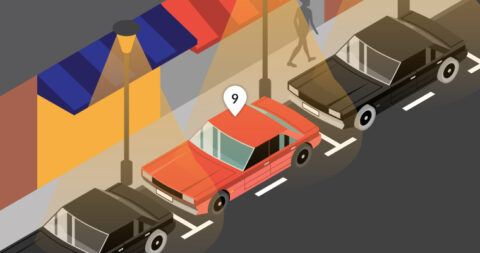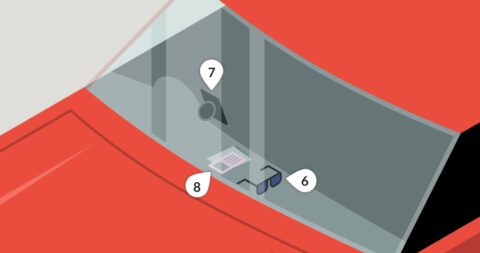| Having your car broken into and losing your things to thieves can be very distressing. Here are a few simple steps you can take to keep your vehicle, and what’s in it, safe.
1. Always lock it Fuelling up or popping back into your house to get something are perfect examples of how easy it is to turn your back for a moment and forget your vehicle is unsecured. So get into the habit of locking your vehicle even if you’re only going to be away from it for a moment. If your vehicle has wing mirrors that fold in automatically when locked, make sure you lock it properly. Criminal gangs are looking for vehicles like these where the wing mirrors are still out because it is clear to them that the vehicle has been left unlocked. 2. Close windows and the sun roof to prevent ‘fishing’ Leaving windows and the sunroof open invites fishing for items through the gap by hand or with, say, a bent coat hanger, which could also be used to unlock a door for them to get in. Thieves can be ingenious. Don’t give them the opportunity. 3. Secure your number plates with tamper-resistant screws The easiest way to change the identity of a stolen vehicle or avoid speeding tickets and parking tickets is to fit stolen number plates. Using security screws to attach your vehicle’s number plates makes it harder for thieves to get your number. 4. Fit locking, anti-tamper wheel nuts to secure alloy wheels Stolen wheels are valuable, either as parts or for their scrap value. Using locking wheel nuts reduces the risk of your vehicle’s wheels being stolen. 5. Secure anything that’s on the outside of your vehicle Anything left on roof-racks, tailgate racks, holiday top boxes or in tool chests are easily stolen when the vehicle is parked. The use of cable locks, padlocks and self-locking tools chests, which are secured to the vehicle, makes them more secure, but still, don’t leave things in them if you can avoid it. 6. Take it with you or hide it Your mobile phone, coins for the car park, sunglasses, packs of medication or other items that can earn quick cash are irresistible to the opportunist thief. Remember, the cost of replacing a window is often much more than that of what’s stolen. And it should go without saying that wallets, handbags, purses and credit cards should never be left in an unattended vehicle. 7. Hide electrical items and leave no clues Leaving sat nav mounts, suction cup marks on windows or cables on view gives it away that you have left a Sat Nav, smartphone or other device in your car. Even if they can’t see the Sat Nav or iPad they might still break in to see if it’s stored in the car, out of sight. 8. Tool theft from vans Vans are often targeted by thieves for the tools stored inside. If you have to leave tools in a van overnight, it’s a good idea to mark them clearly with your name / company name and address using paint pens and seal with a clear lacquer spray. Alternatively, you can use a variety of other property marking systems. Items that are clearly marked are less desirable and more difficult to sell on. Consider using a lockable cabinet within your van to store tools – a number of security rated products are available. Small cameras are also designed to record inside vehicles. You can also take photographs of items of value, make a note of the serial numbers and consider registering them online at a property register site. 9. Park in well-lit and busier areas It can take less than 30 seconds to break into a vehicle. Parking in well-lit areas and busy streets increases the chances of a thief being seen, so they’ll probably steer clear. 10. Take your documents with you Having a vehicle’s registration and insurance documents could let a thief pretend to be the owner. Which means they could sell it on quite easily. So, never leave any documents in the vehicle. 11. Choose your car park wisely If possible, always try to park in well-lit and staffed car parks or those with a Park Mark safer parking award. Catalytic converter theft The precious metal in catalytic converters has led to an increase in their theft. Catalytic converters are devices fitted to vehicle exhausts to reduce the amount of dangerous gases emitted. They are often targeted by thieves as they contain valuable metals and can be removed in less than a minute. Catalytic converter theft most frequently occurs in car parks, but they can happen anywhere. Thieves may then sell these converters via scrapyards, online, or ship them out of the country. Hybrid vehicles are most commonly targeted, as their metals are more valuable, but any vehicle can be at risk of catalytic converter theft. Signs a catalytic converter theft is being committed
Prevent it Although catalytic converter thefts are increasing, there are steps that you can take to protect your vehicle. To keep your catalytic converter safe, you can ask your car dealer for advice on locks or guards that are approved by the vehicle manufacturer. Alternatively, try to make sure your vehicle is parked in a garage overnight, or if you have a commercial vehicle, park it in a secure compound. If this isn’t possible, park in an area that’s well-lit and overlooked and try to park so that the converter can’t be easily reached by potential thieves. Vehicles that sit high above the road are particularly vulnerable. Report it
|



